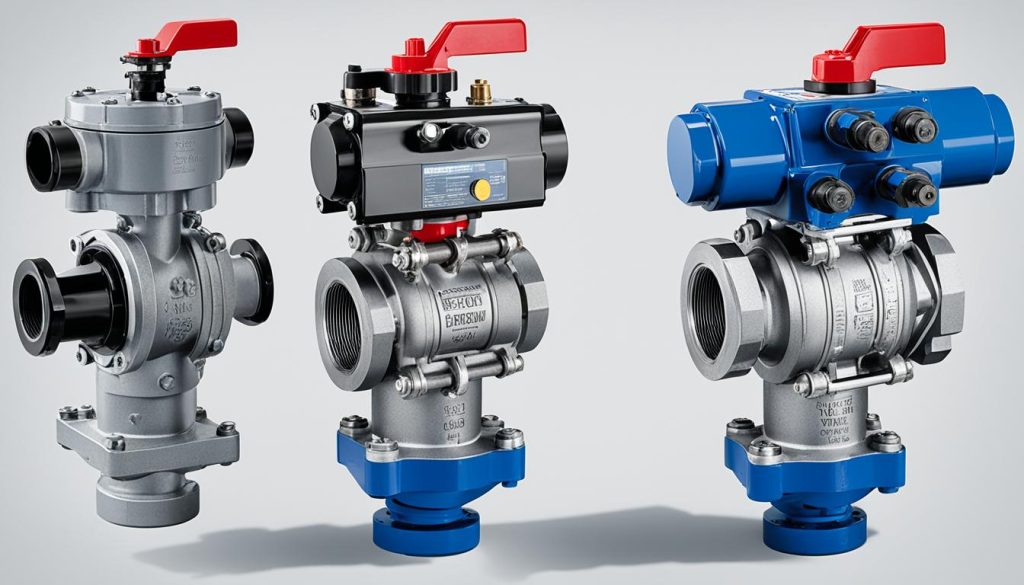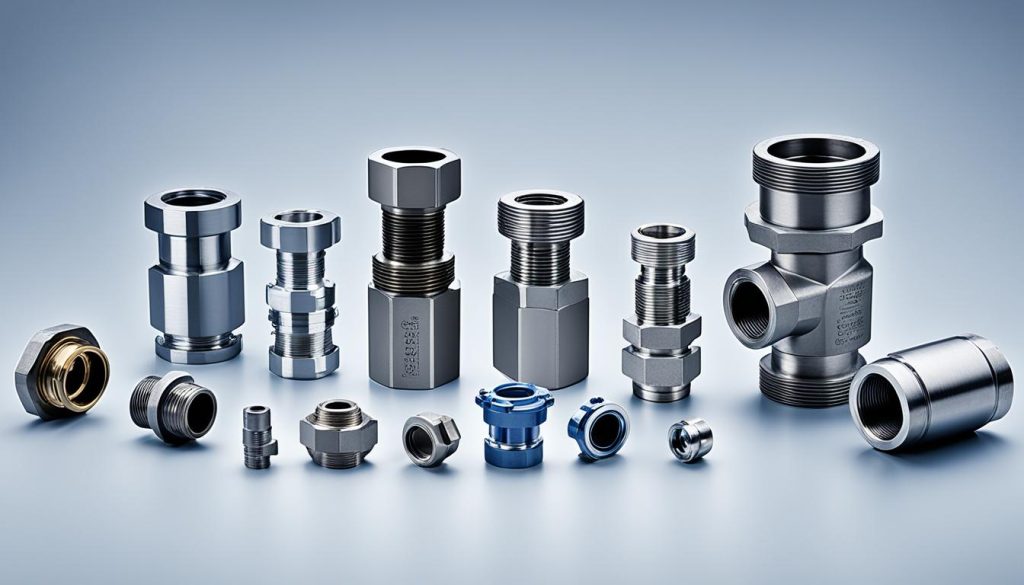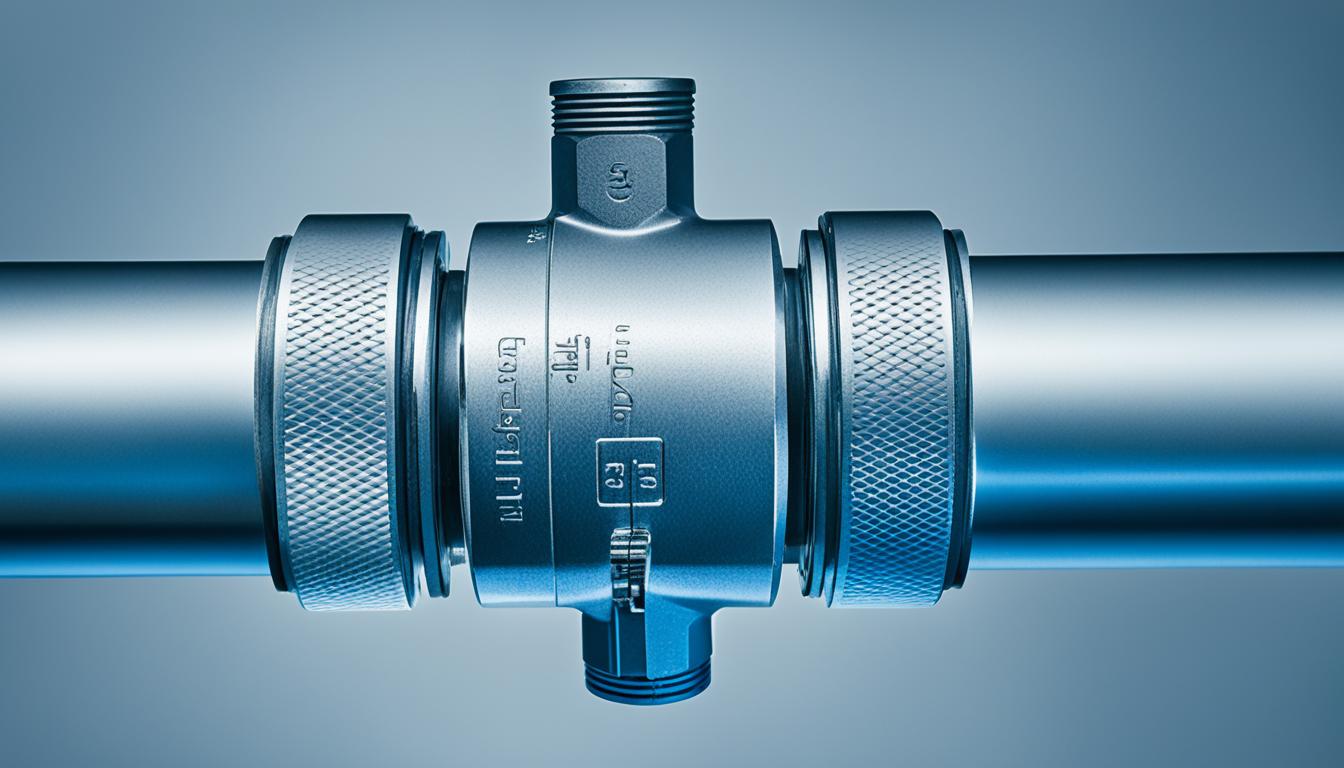Did you know that a single check valve can save thousands of dollars in equipment repairs?
Check valves may seem like simple devices, but they play a critical role in countless industries and systems, ensuring the proper flow direction and preventing backflow that can cause significant damage. Let’s take a closer look at the purpose and function of check valves and why they are essential in protecting pumps, piping systems, and industrial applications.
Key Takeaways:
- A check valve is an automatic safety device that allows one-way flow and prevents reverse flow.
- The main purpose of a check valve is to protect pumps, piping systems, and equipment from damage.
- Check valves come in various types, such as swing check valves, ball check valves, and lift check valves, each suited for different applications.
- They operate based on cracking pressure and have mechanisms like springs, discs, or balls for proper opening and closing.
- Using check valves offers benefits like preventing backflow, water hammer, leaks, and maintaining system efficiency.
Types of Check Valves
When it comes to check valves, there are plenty of options to choose from. Each type of check valve serves a specific purpose and offers unique advantages in different applications. Let’s explore some of the common types:
- Swing check valves: These valves have a hinged disc that swings open to allow flow in one direction and closes to prevent backflow.
- Wafer check valves: Designed to be lightweight and compact, these valves fit between two flanges to regulate flow direction.
- Tilting disc check valves: With a disc that tilts to allow flow and closes to prevent reverse flow, these valves offer quick response and minimal pressure loss.
- Ball check valves: Utilizing a spherical ball as the closure element, these valves provide reliable sealing and low maintenance.
- Butterfly check valves: Featuring a butterfly-shaped disc, these valves offer efficient flow control and minimal pressure drop.
- Lift check valves: These valves consist of a disc lifted by the flow to allow passage and closed by the reverse flow to prevent backflow.
- Silent check valves: Designed for noise reduction, these valves employ special features to minimize pressure surges and vibrations during operation.
- Duckbill check valves: With a flexible rubber sleeve, these valves open under pressure and close when the flow stops, ensuring reliable sealing.
- Diaphragm check valves: Using a flexible diaphragm as the closure element, these valves are suitable for various fluids and provide accurate control.
- Foot check valves: Installed at the bottom of a vertical pipe, these valves prevent fluid from flowing back when the pump is turned off.
- Pneumatic check valves: Specifically designed for pneumatic systems, these valves control the flow direction of compressed air.
Each type of check valve has its own unique design and function, making it suitable for specific applications. The choice of check valve depends on factors such as system requirements, flow characteristics, and operating conditions.
| Check Valve Type | Design | Advantages |
|---|---|---|
| Swing check valves | Hinged disc | Allows flow in one direction, prevents backflow |
| Wafer check valves | Compact and lightweight | Fits between flanges, regulates flow direction |
| Tilting disc check valves | Tilting disc | Quick response, minimal pressure loss |
| Ball check valves | Spherical ball | Reliable sealing, low maintenance |
| Butterfly check valves | Butterfly-shaped disc | Efficient flow control, minimal pressure drop |
| Lift check valves | Lifting disc | Allows passage with flow, prevents backflow |
| Silent check valves | Noise reduction features | Minimizes pressure surges and vibrations |
| Duckbill check valves | Flexible rubber sleeve | Opens under pressure, ensures reliable sealing |
| Diaphragm check valves | Flexible diaphragm | Suitable for various fluids, accurate control |
| Foot check valves | Installed at pipe bottom | Prevents backflow when pump is off |
| Pneumatic check valves | For pneumatic systems | Controls flow direction of compressed air |
Understanding the different types of check valves allows for informed decision-making when selecting the most suitable valve for a specific application.
How Does a Check Valve Work?
In order to understand how a check valve works, we must first grasp the concept of cracking pressure. A check valve operates by requiring a minimum upstream pressure to open the valve, allowing fluid or gas to flow in one direction. The cracking pressure can vary depending on factors such as the size of the valve, its design, and the specific application it’s used in.
When the pressure exceeds the cracking pressure, the check valve opens, allowing flow to occur. Conversely, if the pressure drops below the cracking pressure or there is back pressure, the valve closes, preventing any reverse flow. This mechanism is essential in maintaining the integrity of a system and preventing any potential damage or disruption caused by backflow.
Check valves utilize various mechanisms to ensure proper opening and closing. These can include springs, discs, balls, diaphragms, or flappers. Each mechanism is carefully designed to efficiently regulate the flow of fluid or gas, providing reliable performance in different applications.
Key Features of Check Valve Mechanisms:
- Check valves with spring mechanisms utilize the force of the spring to hold the valve closed until the cracking pressure is reached, allowing the flow in one direction.
- Disc and ball check valves operate by using the flow of fluid or gas to push the disc or ball away from the seat, enabling the flow in one direction. When there is a reversal of flow, the disc or ball seats itself, preventing any backflow.
- Diaphragm check valves employ a flexible rubber or elastomer diaphragm to control the flow. When the pressure is higher on one side, it causes the diaphragm to flex, opening the valve. When the pressure is higher on the other side, the diaphragm returns to its original position, closing the valve and preventing backflow.
- Flapper check valves consist of a hinged flap that swings open in the direction of flow and closes under the force of gravity or back pressure. This design ensures that flow is only permitted in the desired direction.
With their innovative mechanisms and precise control over flow direction, check valves play a vital role in numerous industries, safeguarding systems, preventing damage, and ensuring efficient operation.
Benefits and Importance of Using Check Valves
Using check valves provides numerous benefits and plays a vital role in various industries. Allow me to elaborate on the advantages and significance of incorporating check valves in your systems.
Prevention of Backflow
A key benefit of using check valves is their ability to prevent backflow, which can cause significant damage to pumps and equipment. By allowing fluids or gases to flow in one direction and automatically closing to prevent reverse flow, check valves ensure the integrity and safety of your systems.
Protection Against Water Hammer
Check valves also offer protection against water hammer, a phenomenon that occurs when the fluid slams against a closed check valve, potentially causing damage. By effectively controlling the flow and preventing sudden pressure surges, check valves safeguard your equipment and maintain system stability.
Ensuring Proper Flow Direction
One of the vital functions of check valves is to ensure the proper flow direction within your systems. By allowing flow in one direction while preventing backflow, check valves maintain the efficiency and effectiveness of your operations.
Leak Prevention
Check valves act as a barrier against leaks, minimizing the risk of system failures and potential environmental hazards. The automatic closing mechanism of check valves ensures that there is no unintended fluid or gas leakage, enhancing overall system reliability.
Maintaining System Efficiency
By preventing backflow and leaks, check valves contribute to maintaining system efficiency. A properly functioning check valve optimizes the flow rate, reduces energy consumption, and maximizes the lifespan of your equipment.
Safeguarding Equipment and Preventing Shutdowns
The importance of using check valves lies in their ability to safeguard equipment from damage and prevent costly system shutdowns. By preventing backflow, water hammer, and leaks, check valves help maintain the smooth operation of your systems, minimizing downtime and repair expenses.
Reducing the Risk of Costly Repairs
By incorporating check valves, you reduce the risk of costly repairs caused by backflow, water hammer, and system failures. The installation of check valves at critical points within your systems provides an essential layer of protection, enhancing the longevity and reliability of your equipment.
Overall, the benefits and importance of using check valves are evident in their ability to prevent backflow, protect against water hammer, ensure proper flow direction, prevent leaks, maintain system efficiency, safeguard equipment, and reduce the risk of costly repairs. Incorporating check valves in your systems is a wise investment that ultimately leads to improved performance, increased productivity, and peace of mind.
Check Valve Applications
Check valves are versatile devices that find applications in various industries and systems. Let’s explore some of the key areas where check valves are commonly used:
- Pump Systems: One of the primary applications of check valves is in pump systems. They play a crucial role in maintaining the desired flow direction and preventing backflow, ensuring efficient and reliable pump operation.
- Oil and Gas Industry: Check valves are widely employed in the oil and gas industry to prevent flow reversal, which can cause severe damage to equipment and pipelines. They help safeguard the integrity of critical infrastructure and enhance safety.
- Industrial Processes: Check valves are essential in industrial processes that involve the handling of different media. They ensure the separation of liquids, gases, or other substances, maintaining the required conditions and preventing cross-contamination.
- Water Pump Systems: In water pump systems, check valves are used to prevent backflow and maintain the desired water flow direction. This prevents damage to the pump and ensures efficient water distribution.
- HVAC Systems: Check valves play a vital role in heating, ventilation, and air conditioning (HVAC) systems. They help regulate the flow of fluids, ensuring optimal system performance and preventing unwanted reverse flow.
- Sewer Pipes: Check valves are commonly installed in sewer pipes to prevent the backflow of sewage or wastewater. This helps maintain the hygiene and integrity of the sewage system, preventing contamination.
- Domestic Appliances: Check valves are also found in various domestic appliances like dishwashers and washing machines. They help control the flow of water, preventing backflow and ensuring efficient operation.
In addition to these applications, check valves have numerous other uses in different industries and systems, highlighting their versatility and importance in ensuring safe and reliable operations.

Materials and Selection Criteria for Check Valves
When it comes to check valves, selecting the right materials is essential for ensuring their performance and longevity. Check valves can be made from various materials, including plastic, stainless steel, and bronze. The choice of material depends on several factors such as the type of fluid or gas being handled, temperature, pressure, corrosion resistance, and system requirements.
In corrosive environments, materials like stainless steel or high-grade plastics are often preferred due to their excellent resistance to chemical reactions. Stainless steel is particularly suitable for applications involving harsh chemicals, acids, or seawater. On the other hand, plastic check valves are lightweight, cost-effective, and resistant to various corrosive substances.

For applications with moderate corrosive conditions, bronze check valves can be a reliable choice. Bronze offers good resistance to corrosion, making it suitable for water, oils, and various non-corrosive fluids.
When selecting a check valve, it is crucial to consider multiple factors to ensure optimal performance. These factors include the flow rate, pipe size, velocity, and pumping mechanism. The flow rate determines the required valve size to handle the desired volume efficiently. Pipe size compatibility ensures a secure and leak-free connection. The velocity of the fluid or gas passing through the valve affects its pressure drop and potential cavitation, while the pumping mechanism considers factors such as gravity flow, pressure, or suction applications.
By carefully evaluating these criteria and selecting the appropriate check valve materials, you can ensure the safe and efficient operation of your system, protecting both the equipment and the overall process.
| Material | Advantages | Disadvantages |
|---|---|---|
| Plastic | Lightweight, cost-effective, resistant to corrosion and chemicals | Lower temperature and pressure limits compared to metal |
| Stainless Steel | Excellent corrosion resistance, suitable for harsh environments and chemicals | Higher cost compared to other materials |
| Bronze | Good resistance to corrosion, suitable for water and non-corrosive fluids | Not ideal for highly corrosive environments |
Check Valve Symbols and Diagrams
When it comes to understanding check valves in industrial systems, the use of symbols and diagrams plays a significant role. These visual representations provide a clear depiction of the presence and function of a check valve within a system, helping engineers, technicians, and operators comprehend the system layout. By understanding check valve symbols, they can ensure the correct installation and positioning of check valves in a system.
Check valve symbols are vital for effective communication and troubleshooting in industrial processes. They serve as a common language among professionals, allowing them to quickly identify and assess the presence of check valves in a system. With these symbols, engineers and technicians can accurately interpret schematics and diagrams, making it easier to diagnose issues and implement necessary repairs or modifications.
Whether it’s a swing check valve, wafer check valve, or any other type, check valve symbols provide a visual representation that facilitates efficient system analysis. By recognizing and interpreting these symbols, professionals can ensure the smooth operation of systems, prevent backflow, and protect vital equipment from potential damage.
